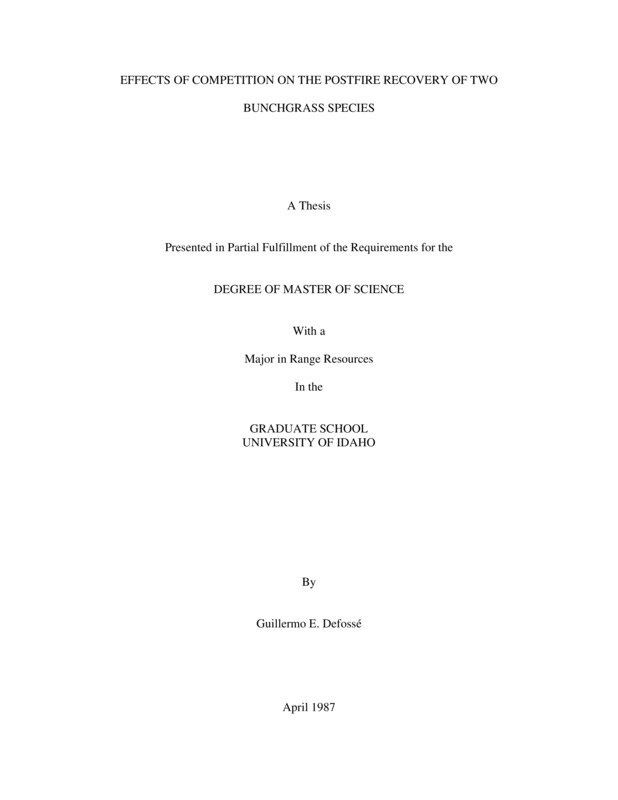PDF PREVIEW
Effects of Competition on the Postfire Recovery of Two Bunchgrass Species Item Info
- Title:
- Effects of Competition on the Postfire Recovery of Two Bunchgrass Species
- Creator:
- Defosse, Guillermo E.
- Date Created:
- 1987-04
- Description:
- The relative fire effects of fire and competition on two bunchgrass species native to western North America, Agropyron spicatum and Festuca idahoensis, were investigated. These species were exposed to fire applied with a portable instrument that allowed control of fire temperature and duration for treatment of individual plants. Thirty plants of each species were subjected to different levels of competition by periodically removing all or part of the aerial biomass of neighboring plants within a radius of 0.6 m around a monitored bunchgrass plant. All plants received the same level of fire severity, an index of fire exposure calculated from the temperature/time integral for the meristematic crown region. No significant mortality due to fire was observed for plants of either species. Although Festuca did show meristematic tissue damage after fire, regrowth was more rapid than Agropyron, and was initiated within 15 days. Soil water availability restricted the regeneration of Festuca bunchgrass more than Agropyron. Only Agropyron plants without competition reached prefire productivity levels. Soil water potential was significantly more negative, by up to 50% for the 0-10-cm soil depth and up to 20% for the 10-20-cm soil depth, in plots with competition during the growing season. Temperatures in the upper 10-cm of the soil profile were significantly higher in plots without competition. Competition restricted aboveground productivity by approximately 70% for Agropyron and 115% for Festuca. Root production was inversely proportional to the degree of competition imposed for both species. The results suggest that both species are tolerant of fire under the fire severity imposed in this study. Their capacity to survive fires seems to be more related to the location of their respective root systems within the soil layers and to their capacity to compete for available soil water in the first stages of regrowth after the fire, than to the damaging effects caused directly by the fire.
- Document Type:
- Thesis
- Library Call Number:
- SB197.D4 1987
- Subjects:
- East Hatter Creek bunchgrass postfire recovery agropyron spicatum festuca idahoensis range resources
- UIEF Unit:
- East Hatter Creek
- Location:
- UIEF; East Hatter Creek
- Latitude:
- 46.840526
- Longitude:
- -116.780027
- Department:
- Department of Rangeland Science
- Type:
- Text
- Format:
- application/pdf
Source
- Preferred Citation:
- "Effects of Competition on the Postfire Recovery of Two Bunchgrass Species", UIEF Research Exchange, University of Idaho Library Digital Collections, https://www.lib.uidaho.edu/digital/uief/items/uief_0096.html
Rights
- Rights:
- In copyright, educational use permitted.
- Standardized Rights:
- http://rightsstatements.org/vocab/InC-EDU/1.0/

